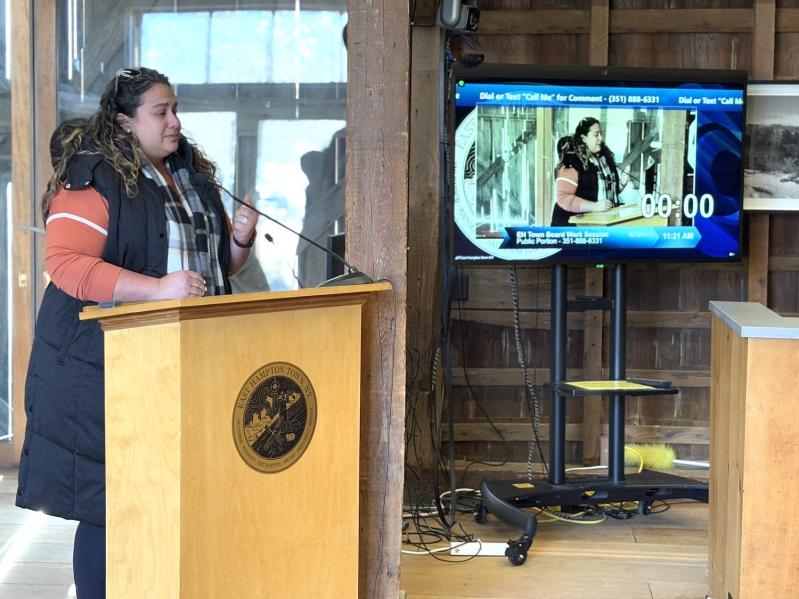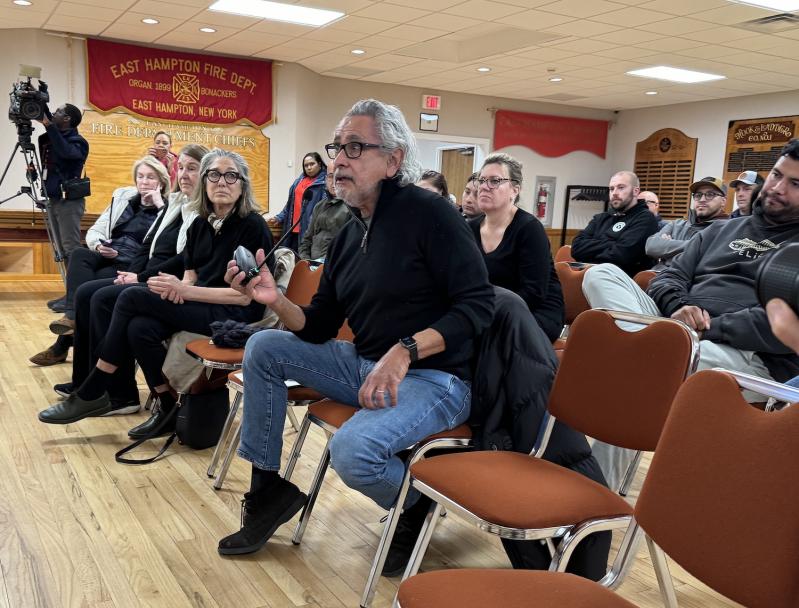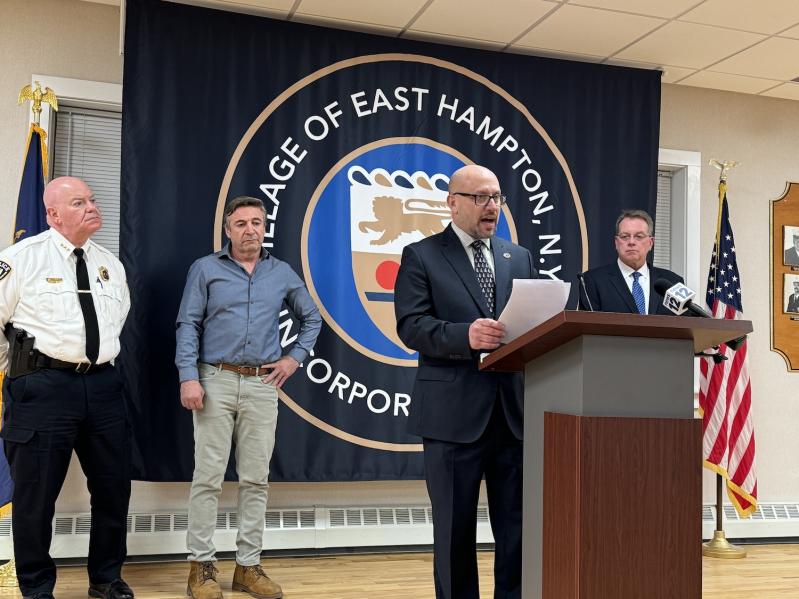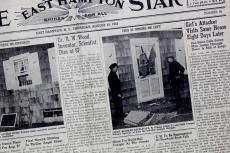An emotional East Hampton Town Board meeting Tuesday began with a two-hour public outpouring of support for the Latino community, mixed with confusion and countless questions about what ordinary people can do in the face of deportation threats from the Trump administration.
Town Supervisor Kathee Burke-Gonzalez read prepared remarks and announced that the town was looking to hire an immigration attorney. Police Chief Michael Sarlo attempted to reassure residents, telling them that his police officers were not Immigration and Customs Enforcement agents.
Further, Ms. Burke-Gonzalez said that in the next two weeks she and the police chief would be meeting with all four local school superintendents and with the heads of local groups such as Organizacion Latino-Americana of Eastern Long Island and Ruta 27.

Daniela Rivas, the seventh of over 20 residents to speak at the town board meeting, was overwhelmed as she approached the microphone. “It’s really hard for me when my 10-year-old daughter asked me, ‘Mom, are you legal?’ I’m sure this place would be full of people,” she said, gesturing to a half-full Town Hall, “but they’re scared. The most important thing we need to focus on right now is our kids. While they’re at school, they’re scared that when they go back home their parents won’t be there.”
Later in the day, East Hampton Village Mayor Jerry Larsen held a press event alongside Sag Harbor Mayor Thomas Gardella, East Hampton Village Police Chief Jeffrey Erickson, and Adam Fine, superintendent of the East Hampton School District. Each official gave a short statement emphasizing the point that all community members, regardless of immigration status, should feel safe when calling the police, the fire department, or the local ambulance service. Sandra Melendez, an East Hampton Village trustee who is also an immigration attorney, delivered Mayor Larsen’s message in Spanish.
As president of the East End Mayors Association, Mr. Larsen said he “represents the 10 villages that are in our five East End towns” and that they were “all on the same page.”
At the town board meeting earlier, there were myriad questions.
“What legal rights do churches have to protect individuals from being detained or questioned by authorities on their premises?” asked Yasmin Marin. A week ago, President Trump rescinded a policy that prevented ICE agents from making arrests in churches and schools. There was no direct answer to her question.

At the villages’ event, Alex Verdugo, owner of Climbers Tree Care Specialists in East Hampton, asked a similar question but from the perspective of a business owner and the rights he has to protect his workers.
Ms. Melendez, also an immigration attorney, assured him that he would “not have to accommodate them [ICE],” and that no one can be forced to answer questions.
“Our level of participation and cooperation with ICE lies in criminal matters,” Chief Sarlo told the town board earlier. “If there’s a signed warrant by a judge on criminal matters, we have a duty to honor and support their efforts to ensure that the warrant is served properly.” A civil warrant would not lead to detention, he said. Criminal warrants are rare, and usually involved sex offenders, repeat D.W.I. offenders and those arrested for violent assault. In the last five years, he said his department has received requests for only five detentions and only one of those people was transported to the Suffolk County jail. “I haven’t seen an ICE agent in this town in I can’t tell you how long,” he said.
“We want to make it very clear that victims of crimes, or those involved in a report made to the Police Department, if you need an ambulance or if you want to report something that happens in your home, we do not ask, we’re not allowed to ask, anyone’s citizenship status. We really need to make sure that all people residing in our communities feel safe reporting crime and coming to us in their times of need,” Chief Sarlo said, noting that three of the last seven hires by his department were Spanish speaking.
Even the police chief grew a bit emotional when pressed by a community member on whether he could step in to stop a deportation. “You see what I’m wearing here,” he said, pointing to his gun. “People who wear this and put this on don’t interfere with other people who wear this and put this on because then people die. You don’t step in front of an Immigration Enforcement officer in uniform with a gun and a badge who’s taking his action. That’s for attorneys to get involved in and that is for policies and procedures through the state to get involved.”
Susan Menu of Springs, who showed up at both meetings, asked for clarification from Chief Erickson about whether the village could hold someone for ICE. “I may have misunderstood,” she said, “but I thought I read something in the newspaper that if there is a detainer from ICE you will hold that person until ICE comes to get them?”
“That is not correct,” Chief Erickson said. “If it is an ICE detainer or an administrative warrant, we do not have the authority, we will not hold them.”
During the town board meeting, David Hillman, an Amagansett resident, read the news to the town board from his phone that Nassau County Executive Bruce Blakeman had given authority to 10 detectives in the Nassau County Police Department to work directly with ICE agents. The report sent a chill through the room, as Nassau County, at least, seemed to be going in the opposite direction.
“The only way any of my officers could ever enforce federal immigration law is if they were deputized,” said Chief Sarlo. “The town board would not allow any of our officers to be deputized.”
Suffolk County Executive Ed Romaine, a Republican, had not returned a request for comment on the matter by yesterday morning.
Town board members were resolute and earnest in their messaging.
“The rules are being rewritten by the second,” said Councilwoman Cate Rogers. “I want to assure everyone that this is the beginning of a conversation. It’s not a one-and-done statement, ‘Okay we did our job let’s move on.’ We’re invested. We’re your neighbors, and we’re with you.”
“I think we all have to recognize we don’t know what’s coming,” said Councilman Ian Calder-Piedmonte, “and we should be prepared to address new information.”
“This realm of fear and chaos, it’s a management style,” said Councilman Tom Flight. “It creates knockdown effects for us as well. The way to overcome that is with knowledge and access to learning.”
However, the fear and chaos style was perhaps already having its intended effect, and rumors had begun circulating in the Latino community.
Distress and uncertainty acted as the twin themes of many comments. Prudence Carabine heard from a group of Latino housemates that ICE agents were in the East Hampton Village manufactured home community on Oakview Highway. Others reported having seen people wearing ICE shirts. “I don’t know the truth,” she said, and wondered what she would do if ICE came pounding on her door.
“There is a lot of uncertainty,” said Raul Guazhambo, a local real estate agent. “In the midst of this, it is a time really to reflect. It’s a time to reflect about asking ourselves the kind of legacy that we want to leave behind to our kids, to the new generations.”
Looking ahead, OLA’s executive director, Minerva Perez, will lead a community conversation on immigration concerns on Feb. 19 from 4 to 9 p.m. at St. Luke’s Episcopal Church in East Hampton, with clergy from East Hampton, Sag Harbor, and Bridgehampton and other local leaders invited.
Those interested in attending have been asked to R.S.V.P. to the church office at 631-329-0990.




